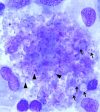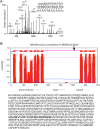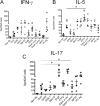Novel pneumocystis antigen discovery using fungal surface proteomics
- PMID: 24686066
- PMCID: PMC4019171
- DOI: 10.1128/IAI.01678-13
Novel pneumocystis antigen discovery using fungal surface proteomics
Erratum in
- Infect Immun. 2014 Aug;82(8):3513
Abstract
Pneumonia due to the fungus Pneumocystis jirovecii is a life-threatening infection that occurs in immunocompromised patients. The inability to culture the organism as well as the lack of an annotated genome has hindered antigen discovery that could be useful in developing novel vaccine- or antibody-based therapies as well as diagnostics for this infection. Here we report a novel method of surface proteomics analysis of Pneumocystis murina that reliably detected putative surface proteins that are conserved in Pneumocystis jirovecii. This technique identified novel CD4(+) T-cell epitopes as well as a novel B-cell epitope, Meu10, which encodes a glycosylphosphatidylinositol (GPI)-anchored protein thought to be involved in ascospore assembly. The described technique should facilitate the discovery of novel target proteins for diagnostics and therapeutics for Pneumocystis infection.
Figures




References
-
- Zheng M, Ramsay AJ, Robichaux MB, Norris KA, Kliment C, Crowe C, Rapaka RR, Steele C, McAllister F, Shellito JE, Marrero L, Schwarzenberger P, Zhong Q, Kolls JK. 2005. CD4+ T cell-independent DNA vaccination against opportunistic infections. J. Clin. Invest. 115:3536–3544. 10.1172/JCI26306 - DOI - PMC - PubMed
Publication types
MeSH terms
Substances
Grants and funding
LinkOut - more resources
Full Text Sources
Other Literature Sources
Research Materials

